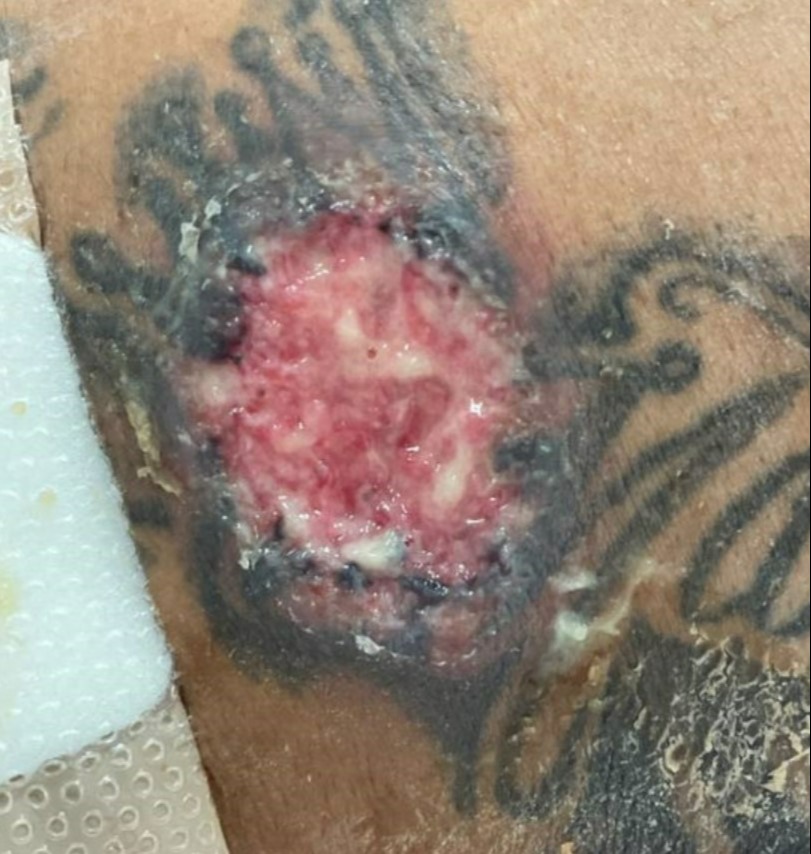Back
Poster Session E - Tuesday Afternoon
E0421 - A Classic Cutaneous Manifestation of Newly Diagnosed Ulcerative Colitis
Tuesday, October 25, 2022
3:00 PM – 5:00 PM ET
Location: Crown Ballroom
- JM
Jordan C. Malone, DO
University of Texas Medical Branch
Galveston, TX
Presenting Author(s)
Jordan C. Malone, DO, Ernesto A. Zamora, MD, Isaiah Reeves, MD, Andrei Loghin, MD, Sheharyar K. Merwat, MBBS
University of Texas Medical Branch, Galveston, TX
Introduction: Pyoderma gangrenosum (PG) is a rare dermatologic manifestation with an incidence of only 3 to 10 cases per million people per year. Though rare, PG and its association with systemic inflammatory disease is well described. This ulcerative, non-infectious neutrophilic dermatosis is most associated with inflammatory bowel disease (IBD) and is specifically associated with ulcerative colitis (UC) in 5 to 12% of cases, although fewer than 3% of patients with UC develop PG. Here we describe a case of a 36-year-old male who presented with progressively worsening bloody diarrhea associated with an exquisitely painful, ulcerative right shoulder lesion that was treatment-refractory to multiple courses of antibiotics.
Case Description/Methods: A 36-year-old man with no significant past medical history presented with three weeks of watery diarrhea often mixed with blood and associated with generalized abdominal pain, weight loss, and malaise. He also reported a worsening right anterior shoulder lesion that he noticed prior to the onset of his gastrointestinal complaints and was refractory to treatment with courses of both TMP-SMX and minocycline. Initial CT imaging revealed pancolitis with perirectal and right lower quadrant reactive lymphadenopathy. Dermatopathology of the lesions obtained during admission revealed diffuse dermal neutrophilic infiltrates consistent with PG. He underwent colonoscopy which revealed inflammation in a continuous and circumferential pattern from rectum to cecum with no colonic sites spared. Tissue samples obtained during colonoscopy returned consistent with ulcerative pancolitis. He was started on intravenous steroids for three days followed by a switch to oral steroids with a marked improvement in abdominal pain, diarrhea, and appearance of the skin lesion. He was discharged with outpatient Gastroenterology follow up where he was initiated on biological therapy with continued improvement in symptomatology.
Discussion: The prevalence of extraintestinal manifestations (EIM) in patients with IBD range from 6 to 47%. This case exhibits how EIMs can be commonly misdiagnosed and subsequently mistreated, especially if dermatologic disease precedes the onset of gastrointestinal complaints. This case reinforces the importance of a detailed history and physical exam while ensuring documentation of an accurate timeline of symptom onset. This case also displays the importance of proper review of symptoms and further workup of dermatological lesions prior to assuming infectious etiology.

Disclosures:
Jordan C. Malone, DO, Ernesto A. Zamora, MD, Isaiah Reeves, MD, Andrei Loghin, MD, Sheharyar K. Merwat, MBBS. E0421 - A Classic Cutaneous Manifestation of Newly Diagnosed Ulcerative Colitis, ACG 2022 Annual Scientific Meeting Abstracts. Charlotte, NC: American College of Gastroenterology.
University of Texas Medical Branch, Galveston, TX
Introduction: Pyoderma gangrenosum (PG) is a rare dermatologic manifestation with an incidence of only 3 to 10 cases per million people per year. Though rare, PG and its association with systemic inflammatory disease is well described. This ulcerative, non-infectious neutrophilic dermatosis is most associated with inflammatory bowel disease (IBD) and is specifically associated with ulcerative colitis (UC) in 5 to 12% of cases, although fewer than 3% of patients with UC develop PG. Here we describe a case of a 36-year-old male who presented with progressively worsening bloody diarrhea associated with an exquisitely painful, ulcerative right shoulder lesion that was treatment-refractory to multiple courses of antibiotics.
Case Description/Methods: A 36-year-old man with no significant past medical history presented with three weeks of watery diarrhea often mixed with blood and associated with generalized abdominal pain, weight loss, and malaise. He also reported a worsening right anterior shoulder lesion that he noticed prior to the onset of his gastrointestinal complaints and was refractory to treatment with courses of both TMP-SMX and minocycline. Initial CT imaging revealed pancolitis with perirectal and right lower quadrant reactive lymphadenopathy. Dermatopathology of the lesions obtained during admission revealed diffuse dermal neutrophilic infiltrates consistent with PG. He underwent colonoscopy which revealed inflammation in a continuous and circumferential pattern from rectum to cecum with no colonic sites spared. Tissue samples obtained during colonoscopy returned consistent with ulcerative pancolitis. He was started on intravenous steroids for three days followed by a switch to oral steroids with a marked improvement in abdominal pain, diarrhea, and appearance of the skin lesion. He was discharged with outpatient Gastroenterology follow up where he was initiated on biological therapy with continued improvement in symptomatology.
Discussion: The prevalence of extraintestinal manifestations (EIM) in patients with IBD range from 6 to 47%. This case exhibits how EIMs can be commonly misdiagnosed and subsequently mistreated, especially if dermatologic disease precedes the onset of gastrointestinal complaints. This case reinforces the importance of a detailed history and physical exam while ensuring documentation of an accurate timeline of symptom onset. This case also displays the importance of proper review of symptoms and further workup of dermatological lesions prior to assuming infectious etiology.

Figure: Right shoulder lesion on admission
Disclosures:
Jordan Malone indicated no relevant financial relationships.
Ernesto Zamora indicated no relevant financial relationships.
Isaiah Reeves indicated no relevant financial relationships.
Andrei Loghin indicated no relevant financial relationships.
Sheharyar Merwat indicated no relevant financial relationships.
Jordan C. Malone, DO, Ernesto A. Zamora, MD, Isaiah Reeves, MD, Andrei Loghin, MD, Sheharyar K. Merwat, MBBS. E0421 - A Classic Cutaneous Manifestation of Newly Diagnosed Ulcerative Colitis, ACG 2022 Annual Scientific Meeting Abstracts. Charlotte, NC: American College of Gastroenterology.
